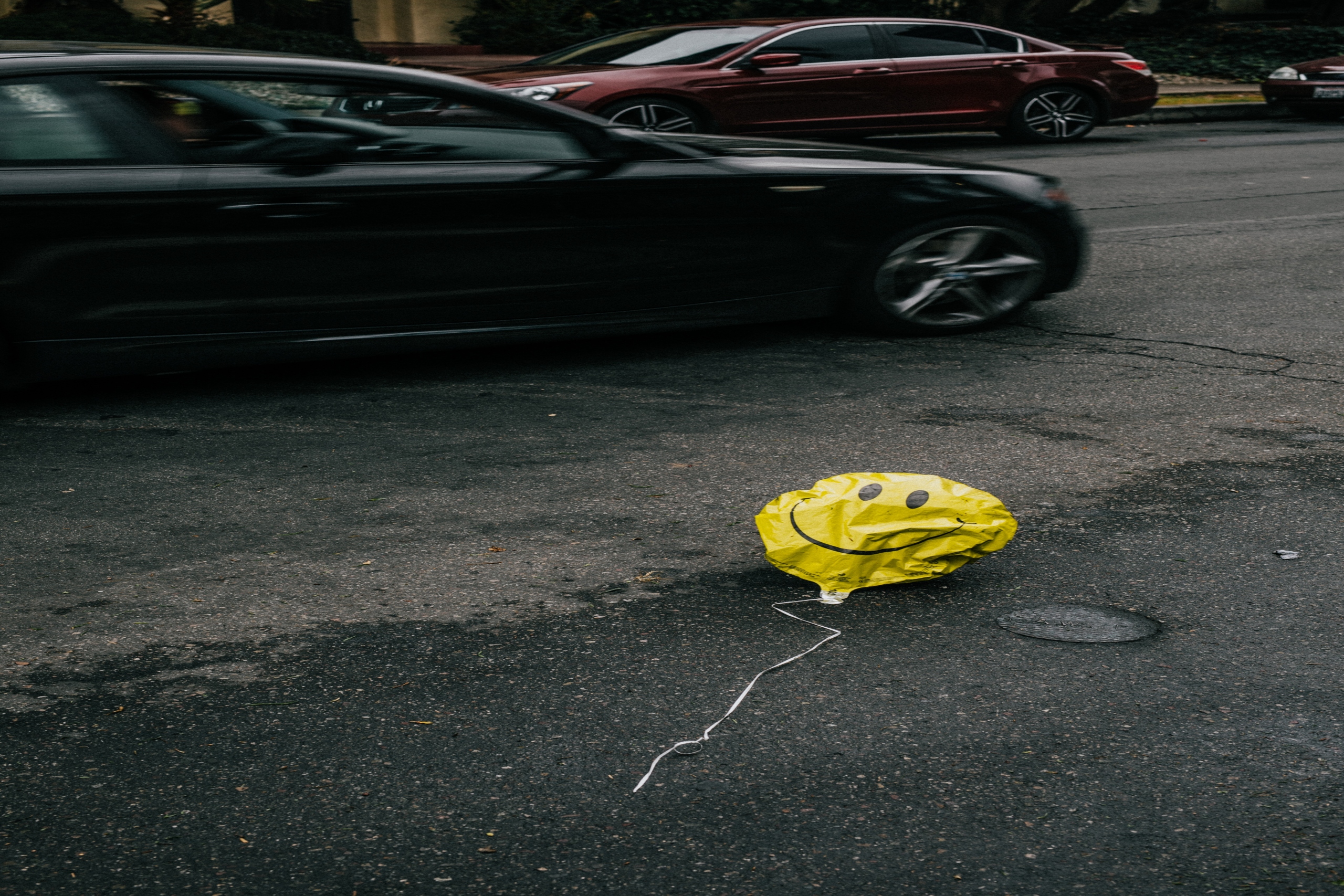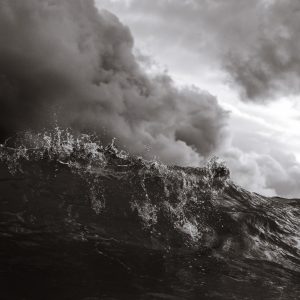I was six when I first met Mr. Balloon. The day before, my parents had taken me to a local carnival. I gorged myself on cotton candy, fascinated by how it vanished instantly in my wet mouth. I begged to fire the fake guns at the shooting range because I had my heart set on a stuffed giraffe hanging on the prize wall, but my parents didn’t approve of guns. To console me, they bought me a bouquet of balloons.
A few minutes later, even though my parents had instructed me to hold on tight to the mass of balloons so buoyant I felt every step would drag me into the sky, I let go. I hadn’t meant to. I’d been distracted by a dog dressed as a clown running wildly through the crowds and clapped in delight, and then the balloons were gone.
“Charles!” my dad said, his voice sharp.
Before my dad could say anything else, my mom cut in. “Don’t worry, Charlie, the balloons are free now.”
“They’re free?” I asked.
“That’s why they rise up into the sky,” my mom assured me, as if the plan all along had been to let the balloons go. “Because they want to be free.”
As I stared at the balloons growing smaller and smaller, I heard my dad mutter, “Well, we sure set that ten bucks free,” and my mom responded with, “Let him be. He feels bad enough as it is.”
But I didn’t feel bad at all. I felt glorious. I set them free!
Which is perhaps why I wasn’t surprised when, the day after the balloons vanished into the sky, Mr. Balloon stepped out from behind the abandoned corner store, a small, electric smile on his stretched-out face. He was taller than my dad and as wide as the refrigerator. He was made entirely of balloons of all different colors and kinds, some shiny and metallic, others plain red rubber, some reading HAPPY BIRTHDAY, and others covered in rainbow patterns. His head was a blank white balloon, his features drawn on with markers.
With a wheezing, high-pitched whistle, he said my name, and I felt as if I’d been born again.
A foolish child, I told my parents about Mr. Balloon. Though I’m sure they thought I was too old for imaginary friends, I was also short of non-imaginary ones. Whether I was outside playing with Carson from down the road or Mr. Balloon, they didn’t care, as long as I was playing outside.
We lived in a part of Houston falling to ruin. Most of the city grew frantically, buildings popping up like weeds. In our neighborhood, houses went for sale, lots were cleared then left to fester, and no one bought anything. People didn’t move in. They moved out, or they died. I followed Mr. Balloon through these barren places, collecting empty cans because they were pretty colors and stacking them in the cupboards of an abandoned house down the street. I wasn’t tall enough to reach the cupboards on my own, but Mr. Balloon lifted me up. His rubbery touch was itchy but endlessly gentle, as if I were a balloon, too, and he was afraid of popping me.
I didn’t question how the houses emptied around us, and my parents just enjoyed the increasing quiet. They worked long hours as middle managers, where all they did was put out fires between co-workers. At home, they barely talked to each other, basking in silence. As a child, all I knew was that they trusted me to be on my own, a fact I was inordinately proud of.
Mr. Balloon never frightened me, though he frightened the other kids I met wandering the streets. I was startled that other kids reacted to Mr. Balloon at all. I’d internalized my parents’ belief in him as imaginary, and imaginary meant invisible. And, at first, whenever a neighborhood kid approached, Mr. Balloon would hide behind a wall or on a roof, or inside a clump of bushes, jumping out only when the strange kid was nearly close enough to touch. And that kid—boy or girl, older or younger—would tear off away from us fast as their legs would carry them.
Each time this happened I was annoyed, because I wanted friends, and Mr. Balloon was made of balloons. Which is to say that after a year, I grew tired of Mr. Balloon. I was seven, too old for imaginary friends.
That is one truth.
The other is that I’d begun to suspect things about Mr. Balloon. That he had a life when I wasn’t around, a life that had absolutely nothing to do with me. As a child, I had trouble accepting that fact. We always met at a fire hydrant that had toppled over long ago like a dead tree. Usually, when Mr. Balloon didn’t show up, I simply returned home to entertain myself inside, but this time I was angry. It was the end of the summer, and we had made plans to climb up the giant oak to see the nest a hawk had built there. I couldn’t make that climb on my own, and I was furious Mr. Balloon had abandoned me since he knew that just as well as I did.
I scoured the neighborhood for him, searching the abandoned houses and trash-filled lots, the fences half-collapsed into makeshift tents. But it wasn’t in any of those places I found him. No, I found Mr. Balloon half-hidden behind a scraggly hydrangea tree, staring at a house across the street, enfolded by police cars and an unhurried ambulance. Some older cops drank coffee in a huddle and laughed. A younger cop knelt in the rough garden raised against the wall of the house, strings of vomit hanging from his chin. Strange fluids dripped from Mr. Balloon’s hands and edged his mouth, making his grin seem much larger than it was. Mr. Balloon glanced at me, then bobbed his head towards the house where something horrible and unknown had taken place. My anger vanished.
“Kid, what are you doing over there?” a cop asked, walking across the street toward me. He wore a smile which was larger than Mr. Balloon’s, but completely false. “Did you see anything? Do you know anything?”
“For God’s sake, Tejani,” another cop said, part of a donut sticking from his mouth like an animal’s leg. “Clearly, he just wants help with his balloon, so help him with the balloon.”
I looked over at Mr. Balloon, but he was gone. In his place was a single helium balloon with its string tangled in the branches higher than I could reach. It read HAPPY BIRTHDAY.
“Here you go, kid,” the cop said as he handed me the balloon, his smile more real this time. “And happy birthday.”
I held on tight to the string until I was safely around the corner of an abandoned house, then I let the balloon go. A breeze immediately tossed it into the spindly fronds of a tall palm tree. The next day, when I went to check, the balloon was gone. I never saw Mr. Balloon again.
I didn’t miss Mr. Balloon. In fact, I was relieved. For years afterwards, my parents told the cute story of my imaginary friend at their regular dinner parties, and everyone laughed, armchair psychologizing my loss of the balloon bouquet as the trauma I was trying to make better.
And, God help me, I believed them.
As a kid, I had an imaginary friend. As an adult, I have a job. My particular job involves looking over architectural plans. I do this job in a basement. Mostly, the plans I’m looking at are for buildings someone wants to tear down, and I’m the last hurdle before they’re allowed to do so, checking to make sure the building isn’t some sort of architectural masterpiece the city should be preserving instead of bulldozing. Because I do my work in the basement, close to the archives I’m constantly sifting through, on some days I might not see the sun at all. I’ll arrive before dawn, eat in the underground tunnels linking downtown’s busy hives of industry, and leave after sunset.
But sometimes, a blueprint isn’t enough. Sometimes I have to drive out to the soon-to-be not-building and make an inspection in person. When I first started this job, I treasured these outings, and inspected houses I didn’t even really need to because I wanted to get to know Houston in a way I never had as a child. I’d take the long way there and back, ignoring freeways in order to hit every stop sign and stop light, soaking up each neighborhood like a piece of bread catching up the last dregs of soup.
The only drawback to going in person was that I might meet the people who lived in the building. If the owner had bought the place to knock it down, no problem. But more and more often, the people I’d meet would accost me because they knew, somehow instinctively, that I could keep their home alive. And when I told them there was a very strict and logical way of determining a building’s historic value, they’d throw eggs at me or key my car or gather a group of their roughest friends and stand, menacingly, before the building as if I was threatening to dismantle with my bare hands.
Now I only leave the office when I must. Today is one of those days. I tried to bribe a co-worker to go in my place, but his car is in the shop, and when I offered him mine, he shook his head.
“Why don’t you want to go?” he asks, suspicion lighting his eyes.
“I’m just not feeling well,” I lie.
“Then you should’ve stayed home,” he says, locking the door to his office.
The truth is I’ve started seeing Mr. Balloon on my trips to evaluate buildings. The first time was a few months ago. I was in an abandoned corner store. Something odd bobbed outside the grime-covered windows, a bulbous shape I couldn’t see clearly. What came to mind, unmistakably, was Mr. Balloon.
I hadn’t thought of Mr. Balloon in years. Seeing a shadow behind cracked glass smeared with dirt and worse things, crusted liquids I didn’t want to think about, and immediately thinking of Mr. Balloon was like seeing a friend from high school a decade later and recognizing them by the way they walk. I was convinced Mr. Balloon’s head floated behind that window, shuddering in the non-existent breeze of a Houston summer. I raced outside, but there was no Mr. Balloon, just a discarded pair of sneakers hanging from a drooping power line.
I signed the death warrant on that corner store as soon as I could. I drove by the building the following week to make sure it had been reduced to a pile of rubble. And since that day, I’d seen Mr. Balloon across the street from buildings I was judging, or trapped in the backseat of a car slowly passing by, or in the middle of a crowd of protesters on the corner. I avoided looking at him, but I knew he knew I knew. The tilt of his big, round head was almost conspiratorial, acknowledging our shared history.
One thing I couldn’t ignore were stories in the Chronicle detailing deaths in the areas I’d seen him. A squatter had been crushed in the demolition of that corner store. A man was found torn to pieces in his backyard, the suspicion resting on a pack of feral dogs. Two children went missing, their shirts and pants found on a clothesline behind an abandoned apartment building, stained with every vile substance this city creates.
And so I went to the houses less and less. I would drive by buildings I was required to judge, snap a picture on my phone, and attempt to do due diligence based on a blurry photograph. The deaths occurred no matter how quickly I drove past. A newly-married couple pummeled to death in their bedroom. A woman found with her arms and legs broken and who’d died of thirst.
When I developed those photographs, Mr. Balloon would be standing on the sidewalk or lurking behind a window, even though I knew he hadn’t been there when I took the picture. In those photographs, I couldn’t help noticing that Mr. Balloon was changing. The balloons making up his body were wilting, the helium going out of them. He’d shrunk, his eyes and mouth curling under the wrinkles of his balloon-skin.
The last photograph is from a week ago, the last time I went out to look at a rotting tenement. In it, I realized he wasn’t shrinking. The balloons were peeling, and beneath those balloons was skin. Skin as bloated and misshapen as his balloon body, but skin all the same.
This is why I’ve been sitting in my car for half an hour, trying to get my breathing slow and even before opening the door to step out into the open air. I don’t see Mr. Balloon at all, but I’m scared. I couldn’t drive by because this house is in the middle of a cramped development, a gated monstrosity taking up an entire block.
It is the middle of the day, and the sun is bright. No one else is around. No cars are on the street. When I open the car door and step onto the sidewalk, I hear a weed wacker growling from a few blocks away. But for that sound, I might as well be alone in Houston. Too much; it reminds me of my old neighborhood, equally abandoned.
I punch in the code to the complex, walk down a smooth concrete alley, and stand outside the tall, narrow house. Water stains trail down from the windows like tear tracks. The stucco walls have collapsed in on themselves, bowing to the city’s oppressive humidity. It’s the neighbors who want this place demolished, while the owner is the one who petitioned for my department to take a look. He claimed it was a unique style by a famous architect, but standing here, it’s obviously nothing special, nothing at all worth saving.
I raise my phone to take a picture and notice movement in the upstairs window. The front door’s cracked open, and I push it open all the way. I want to run, but I think of all of those dead and whether I could’ve helped them. There’s a cry of surprise and a loud thump. A worn sneaker tumbles down the stairs, landing right inside the door.
“Hello?” I call out. “Are you hurt?”
I’m terrified of seeing Mr. Balloon, but I can’t just leave. What if whoever is inside has had a stroke? Or some sort of epileptic fit, and they’ve fallen and hit their head, and if I don’t go in to see, then everything that happens to them is on me?
The smell of rubber wafts through the open door. It smells like childhood. Still, I go in.
Another shoe lies halfway up the stairs. Its gray surface is spattered with blood, the inside coated with it. The air smells of unfilled balloons, coated with powder so they don’t stick together.
At the top of the stairs is one of those open plan rooms where a kitchen, dining room, and living room all butt up against one another. But space is nothing without a defined edge. And that defined edge is in front of me now, an older man whose legs are missing, roughly torn at his hips. He should be dead, but the man raises his hands to me, locks his terrified eyes with mine.
Cradling the old man is Mr. Balloon. He isn’t made of balloons at all anymore. Instead, his tall body is riddled with tumors and growths. His all-too-human eyes are too large and flat. His all-too-human mouth is pursed up like an outie belly button. He caresses the old man’s cheeks. Mr. Balloon is covered in gore. His thin tongue licks his lips clean. He doesn’t look at me.
“I’m sorry,” I say, not sure if I’m apologizing to the old man or Mr. Balloon.
Mr. Balloon grabs the old man’s arm and stretches it taught. The old man screams until Mr. Balloon covers his mouth with his free hand as one might carefully support a wet paper bag threatening to burst open.
“You can watch, Charles.” Mr. Balloon’s voice is the hiss of escaping air. “I don’t mind.”
Mr. Balloon smiles. His teeth are needles. Blood rushes to my face in a blush of shame, and my skin feels swollen all over, like I’m a sausage plumping in the pan. I quickly turn away as Mr. Balloon pulls on that arm, and the skin begins to tear.
Just as quickly, I turn back.




